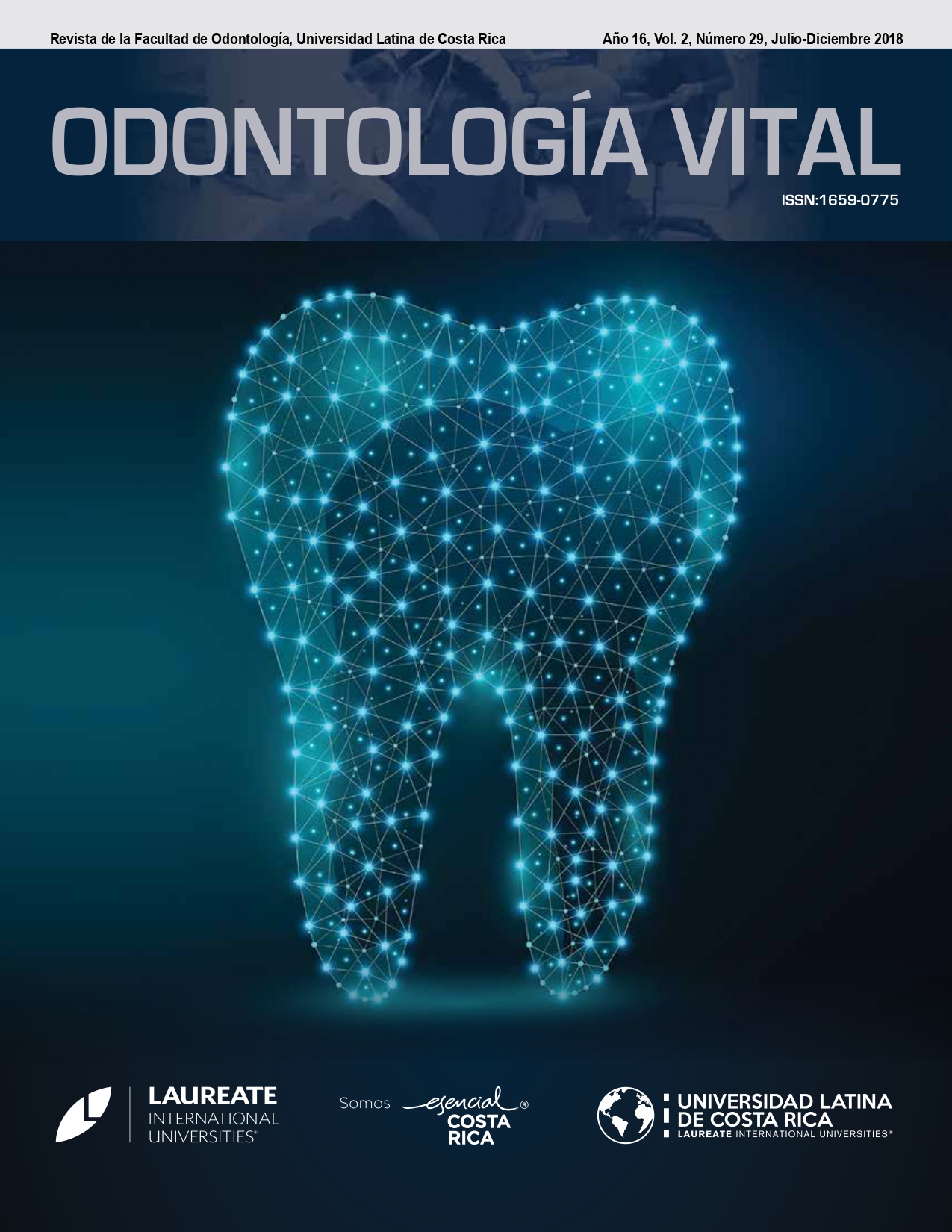Apical plug with bioceramics: treatment of the open apex in one appointment
DOI:
https://doi.org/10.59334/ROV.v2i29.146Keywords:
Dental trauma, open apex, apexification on appointment and bioceramicsAbstract
Dental trauma is a frequent cause of pulp necrosis in anterior teeth, at an early age, which stops root development and complicates case management. Apexification with calcium hydroxide has been the treatment of choice for many years, however, it requires many appointments and it has been reported that its long-term use can weaken the dentinal walls. With the emergence of materials based on bioceramics, it is possible to perform this type of treatment in a single session and with more predictable results. Therefore, the objective of this article is to show the management of the apexification in an appointment by creating an apical plug with MTA and its follow up to 4 years.
Downloads
References
Albadri, S., Chau, Y. S., & Jarad, F. (2013). The use of mineral trioxide aggregate to achieve root end closure: three case reports. Dental Traumatology, 29(6), 469-473. https://doi.org/10.1111/j.1600-9657.2012.01128.x
Andersson, L., Andreasen, J. O., & Christensen, K. F. (2011). Writing an original article for publication in Dental Traumatology. Dental Traumatology, 27(5), 328-333. https://doi.org/10.1111/j.1600-9657.2010.00966.x
Bartols, A., Roussa, E., Walther, W., & Dörfer, C. E. (2017). First Evidence for Regeneration of the Periodontium to Mineral Trioxide Aggregate in Human Teeth. Journal of endodontics, 43(5), 715-722. https://doi.org/10.1016/j.joen.2016.12.027
Botero, T. M., Tang, X., Gardner, R., Hu, J. C., Boynton, J. R., & Holland, G. R. (2017). Clinical Evidence for Regenerative Endodontic Procedures: Immediate versus Delayed Induction. Journal of Endodontics, 43(9), S75-S81. https://doi.org/10.1016/j.joen.2017.07.009
Broon, N. J., & Benítez Cabrera, J. G. (2006). Apicogénesis, apicoformación y maturogénesis: conceptos y técnica. Medicina Oral (16656024), 8(3), 129-138.
Bücher, K., Meier, F., Diegritz, C., Kaaden, C., Hickel, R., & Kühnisch, J. (2016). Long-term outcome of MTA apexification in teeth with open apices. Quintessence International, 47(6).
CAMILLERI J., (2016). Is Mineral Trioxide Aggregate a Bioceramic?.-ODOVTOS-Int. J. Dental Sc., 18-1(January-April): 13-17. https://doi.org/10.15517/ijds.v18i1.23482
Çiçek, E., Yılmaz, N., Koçak, M. M., Sağlam, B. C., Koçak, S., & Bilgin, B. (2017). Effect of Mineral Trioxide Aggregate Apical Plug Thickness on Fracture Resistance of Immature Teeth. Journal of Endodontics, 43(10), 1697-170. https://doi.org/10.1016/j.joen.2017.05.007
Flanagan, T. A. (2014). What can cause the pulps of immature, permanent teeth with open apices to become necrotic and what treatment options are available for these teeth. Australian Endodontic Journal, 40(3), 95-100. https://doi.org/10.1111/aej.12087
Fouad, A. F. (2017). Microbial Factors and Antimicrobial Strategies in Dental Pulp Regeneration. Journal of Endodontics, 43(9), S46-S50. https://doi.org/10.1016/j.joen.2017.06.010
Gomes, B. P. F. A., Souza, S. F. C., Ferraz, C. C. R., Teixeira, F. B., Zaia, A. A., Valdrighi, L., & Souza-Filho, F. J. (2003). Effectiveness of 2% chlorhexidine gel and calcium hydroxide against Enterococcus faecalis in bovine root dentine in vitro. International Endodontic Journal, 36(4), 267-275. https://doi.org/10.1046/j.1365-2591.2003.00634.x
Hong, S. T., Bae, K. S., Baek, S. H., Kum, K. Y., & Lee, W. (2008). Microleakage of accelerated mineral trioxide aggregate and Portland cement in an in vitro apexification model. Journal of endodontics, 34(1), 56-58. https://doi.org/10.1016/j.joen.2007.09.008
Kahler, B., Rossi-Fedele, G., Chugal, N., & Lin, L. M. (2017). An Evidence-based Review of the Efficacy of Treatment Approaches for Immature Permanent Teeth with Pulp Necrosis. Journal of Endodontics. https://doi.org/10.1016/j.joen.2017.03.003
Kaur, M., Singh, H., Dhillon, J. S., Batra, M., & Saini, M. (2017). MTA versus Biodentine: Review of Literature with a Comparative Analysis. Journal of Clinical and Diagnostic Research: JCDR, 11(8), ZG01. https://doi.org/10.7860/JCDR/2017/25840.10374
Lin, J., Zeng, Q., Wei, X., Zhao, W., Cui, M., Gu, J., ... & Ling, J. (2017). Regenerative Endodontics Versus Apexification in Immature Permanent Teeth with Apical Periodontitis: A Prospective Randomized Controlled Study. Journal of Endodontics. https://doi.org/10.1016/j.joen.2017.06.023
Mente, J., Leo, M., Panagidis, D., Ohle, M., Schneider, S., Bermejo, J. L., & Pfefferle, T. (2013). Treatment outcome of mineral trioxide aggregate in open apex teeth. Journal of endodontics, 39(1), 20-26. https://doi.org/10.1016/j.joen.2012.10.007
Silujjai, J., & Linsuwanont, P. (2017). Treatment outcomes of apexification or revascularization in nonvital immature permanent teeth: a retrospective study. Journal of endodontics, 43(2), 238-245. https://doi.org/10.1016/j.joen.2016.10.030
Simon, S., Rilliard, F., Berdal, A., & Machtou, P. (2007). The use of mineral trioxide aggregate in one-visit apexification treatment: a prospective study. International Endodontic Journal, 40(3), 186-197. https://doi.org/10.1111/j.1365-2591.2007.01214.x
Timmerman, A., & Parashos, P. (2017). Delayed Root Development by Displaced Mineral Trioxide Aggregate after Regenerative Endodontics: A Case Report. Journal of endodontics, 43(2), 252-256. https://doi.org/10.1016/j.joen.2016.10.024
Tran, D., He, J., Glickman, G. N., & Woodmansey, K. F. (2016). Comparative Analysis of Calcium Silicate–based Root Filling Materials Using an Open Apex Model. Journal of endodontics, 42(4), 654-658. https://doi.org/10.1016/j.joen.2016.01.015
Downloads
Published
Issue
Section
License
Copyright (c) 2018 Mariela Barzuna Pacheco, Ana María Téllez Cárdenas

This work is licensed under a Creative Commons Attribution 4.0 International License.
Authors who publish with Odontología Vital agree to the following terms:
- Authors retain the copyright and grant Universidad Latina de Costa Rica the right of first publication, with the work simultaneously licensed under a Creative Commons Attribution 4.0 International license (CC BY 4.0) that allows others to share the work with an acknowledgement of the work's authorship and initial publication in this journal.
- Authors are able to enter into separate, additional contractual arrangements for the non-exclusive distribution of the Odontología Vital's published version of the work (e.g., post it to an institutional repository or publish it in a book), with an acknowledgement of its initial publication.
- Authors are permitted and encouraged to post their work online (e.g., in institutional repositories or on their website) prior to and during the submission process, as it can lead to productive exchanges, as well as earlier and greater citation of published work.







